Climate change and the consequences for water supplies in Europe
It is dry and hot in Europe. According to the JRC (Joint Research Centre), the present situation is one of the driest in the last 500 years for the rivers. The Rhine discharge at Lobith fluctuated around 700 m3/s from 16 to 23 August. That is extremely low and it has consequences for shipping and regional water supplies. In a warmer climate, we will be faced with situations of this kind more often. What can we expect in the future for the Rhine? And what measures can we take?
Climate change and the consequences for water supplies in Europe
As temperatures rise and precipitation decreases due to climate change, the combination of heat and drought is becoming more common. This makes water shortages more likely: less water is available on the one hand, while water demand is increasing on the other. As global average temperatures rise, the risk of water scarcity is increasing from ‘moderate’ in the case of 1.5°C warming to ‘high’ in the case of 3°C warming in the West, and from ‘high’ to ‘very high’ in Southern Europe. This results in higher yield losses in agriculture, particularly in Southern Europe.
According to the recent IPCC report, the drought frequency has already risen there. Adaptation measures to reduce agricultural damage include irrigation, changes to agricultural practices, different crops and moving out of high-risk areas. However, the possibilities for more irrigation are limited because of the decline in water availability in rivers, particularly in Southern Europe. In addition, the additional use of water for irrigation could actually exacerbate water shortages for other users.
Other sectors are also being affected. Lower river discharges mean that less hydropower can be generated, there is less water for drinking water purposes, and shipping is hindered more often. The combination with higher temperatures reduces the availability of cooling water for industry, and leads to poorer water quality, with consequences in areas such as drinking water supplies and biodiversity.
The Netherlands
The rivers are an important source of fresh water for the Netherlands. Rhine water is used throughout the lower-lying areas of the country for agriculture, for nature and to maintain water levels in the ditches and polder-drainage canals (for example to prevent land subsidence and for infrastructure such as bridges and houses). In addition to these effects, it is becoming increasingly difficult to keep salt water out.
Excessive salinity levels have negative effects on regional water management but also on drinking water intake on, for example, the Lek River, the Amsterdam-Rhine Canal and the Brielse Meer lake. Emergency measures are then required. An example of an emergency measure of this kind is the Climate-Resilient Water Supply for the Western Netherlands. Another example is limiting lock movements (at the IJmuiden sea locks, for example), with disruption to shipping as a result.
Furthermore, at low discharges, water quality declines because nutrients, drug residues and chemicals are not diluted and because of higher temperatures. This means that drinking water companies have to work harder on treating water, and intake and discharge restrictions for industry become more likely.
There is also a higher probability of intake being suspended temporarily if there is an isolated discharge of chemicals somewhere upstream.
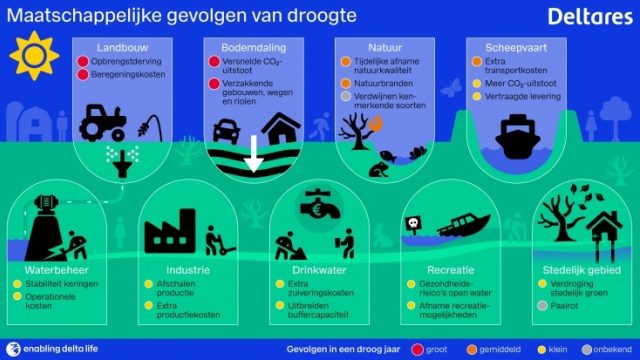
Expectation for the Rhine basin, important source of fresh water
The Rhine is a mixed river type that is fed by both melt water from glaciers and snow, and precipitation. Climate change affects the discharge regime – the average discharge level through the year – in four ways (Figure 1):
- precipitation falls as rain rather than snow more often;
- glaciers retreat, and so the amount of melt water declines;
- the distribution of precipitation over the year changes, with more precipitation on average in winter and less in summer; and
- evapotranspiration increases in line with regional warming.
The disappearance of snow and ice, combined with reduced precipitation in summer, has a major impact on low-discharge events throughout the Rhine basin. The variation in the discharge regime seen in the different KNMI climate scenarios (see Figure 1) reflects the uncertainty in precipitation patterns that is affected by meteorological fluctuations.
G stands for moderate warming, and W for high warming: 1.5°C and 3.5°C, respectively, by the end of this century. L, H, and dry stand for variations in high and low pressure areas, with Wh,dry being the driest scenario for the Rhine basin.
Average summer discharges of the Rhine at Lobith could fall to 1000 m3/s in the case of severe climate change. If a discharge level of this kind occurs, the National Water Allocation Committee comes into action, which is currently considered to represent an emergency. However, in the scenario with high warming (Wh-dry), this will be the average situation. If the glaciers also disappear in the future, average summer discharges will fall even further.
The frequency of extreme discharges is also increasing (Table 1). The duration of low Rhine discharges (the threshold used here is 1020 m3/s) doubles in the Wh-dry scenario, and falls slightly in the moderate scenario. The duration of extremely low discharges (700 m3/s) could even triple. The current Rhine discharge at Lobith was lower than 700 m3/s for more than a week without interruption this summer (Figure 2).
In the past 120 years, the discharge has been this low for more than one week on three previous occasions: 1921, 1947, and 1949 (Figure 3). The Rhine at Lobith is now extremely low for an average of one day a year; this will be 13 days in the Wh-dry scenario.
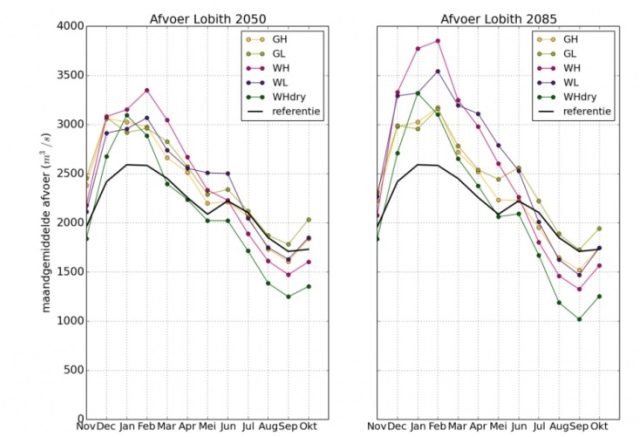
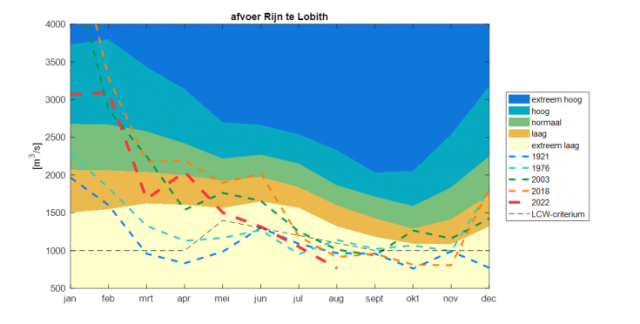
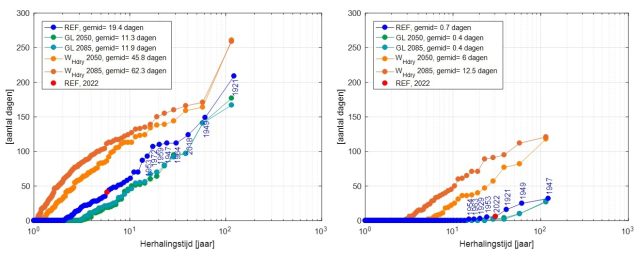
Table 1: Duration (number of days) of a Rhine discharge at Lobith lower than 700 m3/s or 1020 m3/s in two specimen years and with different climate scenarios in the reference year 2085, at different repeat periods. The Rhine at Lobith is now extremely low (<700 m3/s) on one day a year on average; in the WH,dry scenario, this will be the case on 13 days in the reference year 2085.
Please note: 1020 m3/s is the ‘Agreed Low Discharge’, the discharge level below which the river falls about 5% of the time and to which the guaranteed draught for shipping is linked.
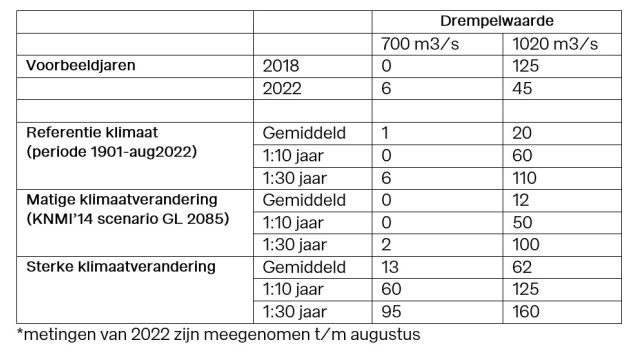
What measures can we take?
To reduce the risk of water shortages, it is important to start using less water. In the Netherlands, however, we are seeing water demand increase as summers get drier and hotter (with higher drinking water consumption and irrigation) but also because of population growth and system interventions such as raising groundwater levels in peatland areas. Part of the increase in water demand is caused by more evapotranspiration, which can only be reduced to a limited extent.
For Dutch agriculture, part of the solution involves irrigating more sparingly and the intelligent selection of crops that require less water or can cope with more brackish water.
In the case of shipping, measures are being explored in the areas of infrastructure, the vessels themselves, logistics and information systems.
We are also seeing water demand increase in the basin as a whole, as a result of which river discharges could fall further. International cooperation in the river basins is therefore essential in order to establish a shared picture of developments and in order to work together on solutions.
The low river discharges of recent months still qualify as an extreme event in the current climate but they may become more frequent in the future. Measures are needed to reduce water use and retain more water, not only in the Netherlands but also in the Rhine and Meuse basins.
Adaptation measures can have a major impact on users, and time is needed to implement them. That is why we must begin now.

